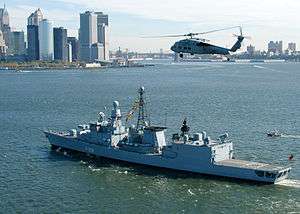Bremen-class frigate
The eight F122 Bremen-class frigates of the German Navy are a series of frigates commissioned between 1982 and 1990. The design is based on the proven and robust Dutch Kortenaer class but uses a different propulsion system and hangar lay-out. The ships were built for anti-submarine warfare as a primary task even though they are not fitted with towed array sonars. They are also suited for anti-aircraft warfare and anti-surface warfare.
.jpg) Emden in July 2009 | |
| Class overview | |
|---|---|
| Builders: |
|
| Operators: |
|
| Preceded by: | Köln-class frigate |
| Succeeded by: | Brandenburg-class frigate |
| Built: | 1979–1990 |
| In commission: | 1982–present |
| Completed: | 8 |
| Active: | 1 |
| Retired: | 7 |
| General characteristics | |
| Type: | Frigate |
| Displacement: | 3,680 tonnes (3,620 long tons) |
| Length: | 130.50 m (428 ft 2 in) |
| Beam: | 14.60 m (47 ft 11 in) |
| Draft: | 6.30 m (20 ft 8 in) |
| Installed power: |
|
| Propulsion: | 2 × propeller shafts, controllable pitch, five-bladed Sulzer-Escher propellers, later replaced with seven-bladed ones from Wegemann & Co. ("Bremen" only) |
| Speed: | 30 knots (56 km/h) |
| Range: | more than 4,000 nmi (7,400 km) at 18 knots (33 km/h) |
| Complement: | 202 crew plus 20 aviation |
| Sensors and processing systems: |
|
| Electronic warfare & decoys: | |
| Armament: |
|
| Aircraft carried: | Place for 2 Sea Lynx Mk.88A helicopters equipped with torpedoes, air-to-surface missiles Sea Skua, and/or heavy machine gun. |
This class of ship was one of the last to be constructed under post-war displacement limitations imposed by the WEU on West Germany.
All eight Bremen-class frigates will be replaced by the planned F125-class frigates, starting around 2016. Prior to that the Bremen class served as the backbone of the German Navy.[1]
Employment
During the Cold War period, the ships' main war task was to escort convoys for reinforcement and resupply of allied forces in Europe in the Northern Atlantic. They frequently took part in NATO Standing Naval Forces. Since 1990, all ships have served in additional supporting missions such as the embargo operations against former Yugoslavia in the Adriatic Sea or Operation Enduring Freedom against the international terrorism.
During their lifetime, the ships' equipment has frequently been modernized and proven to be reliable platforms.
Notable actions
Karlsruhe successfully assisted an Egyptian freighter repel pirates on 25 December 2008 in the Gulf of Aden.
In 2012 Rheinland-Pfalz was reportedly used to gather intelligence on Syrian troop movements to be passed to the Free Syrian Army assist in their attacks on the Syrian Army.[2]
In December 2015 Augsburg joined the French aircraft carrier Charles de Gaulle in the south-eastern Mediterranean Sea to go to the Arabian Sea as part of the intervention against ISIS in the Syrian Civil War.[3][4]
Ships
| Pennant | Name | Builder | Laid down | Launched | Commissioned | Decommissioned |
|---|---|---|---|---|---|---|
| F207 | Bremen | Bremer Vulkan, Bremen | 9 July 1979 | 27 September 1979 | 7 May 1982 | 28 March 2014 |
| F208 | Niedersachsen | AG Weser, Bremen | 9 November 1979 | 9 June 1980 | 15 October 1982 | 26 June 2015[5] |
| F209 | Rheinland-Pfalz | Blohm + Voss, Hamburg | 25 September 1979 | 3 September 1980 | 9 May 1983 | 22 March 2013[6] |
| F210 | Emden | Nordseewerke, Emden | 23 June 1979 | 17 December 1980 | 7 October 1983 | 29 November 2013 |
| F211 | Köln | Blohm + Voss, Hamburg | 16 June 1980 | 29 May 1981 | 19 October 1984 | 31 July 2012[7] |
| F212 | Karlsruhe | Howaldtswerke, Kiel | 10 March 1981 | 8 January 1982 | 19 April 1984 | 16 June 2017 |
| F213 | Augsburg | Bremer Vulkan, Bremen | 4 April 1987 | 17 September 1987 | 3 October 1989 | 30 June 2019 |
| F214 | Lübeck | Nordseewerke, Emden | 1 June 1987 | 15 October 1987 | 19 March 1990 | Planned for 2021 |
All ships are based in Wilhelmshaven. Together they form the 4. Fregattengeschwader (4th Frigate Squadron) of the German Navy.
Gallery
 Frigate F207 Bremen
Frigate F207 Bremen F208 Niedersachsen in New York, 2004
F208 Niedersachsen in New York, 2004 Frigate F211 Köln
Frigate F211 Köln Frigate F209 Rheinland-Pfalz
Frigate F209 Rheinland-Pfalz Frigate F214 Lübeck
Frigate F214 Lübeck Frigate F210 Emden at Portsmouth, UK, 2013.
Frigate F210 Emden at Portsmouth, UK, 2013. Frigate F212 Karlsruhe in London, 2016.
Frigate F212 Karlsruhe in London, 2016.
References
- Fiorenza, Nicholas (24 October 2011). "More Details Of German Cuts". Ares: A Defense Technology Blog. Aviation Week. Archived from the original on 13 November 2013. Retrieved 12 May 2012.
- Reuters (19 August 2012). "Syria rebels aided by Germany intel ship in fight against Assad forces, report says". Haaretz. Retrieved 20 August 2012.
- "Kampf gegen IS-Terror : Fregatte "Augsburg" steht schon unter französischem Kommando". Handelsblatt. 6 December 2015. Retrieved 6 December 2015.
- Deutsche Marine steht an Frankreichs Seite, Bundesministerium der Verteidigung, 3 December 2015, retrieved 6 December 2015
- marine.de
- "Kein Abschied für immer". 22 March 2013. Retrieved 7 June 2013.
- "Fregatte Köln: Ein letztes Kölsch zum Abschied". Express.de. 1 August 2012. Retrieved 22 February 2013.
Sources
- Website for all active and retired Frigate F213 Seamen
- "Fregatte BREMEN-Klasse" (in German). Deutsche Marine. Retrieved 4 August 2008.
- naval-technology.com
- https://www.nytimes.com/2008/12/26/world/africa/26pirates.html?ref=world
- http://news.bbc.co.uk/2/hi/africa/7799796.stm
External links
